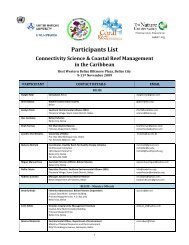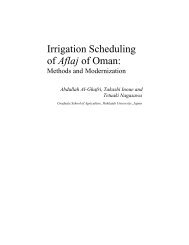The Global Water Crisis: Addressing an Urgent Security - Unu-inweh ...
The Global Water Crisis: Addressing an Urgent Security - Unu-inweh ...
The Global Water Crisis: Addressing an Urgent Security - Unu-inweh ...
You also want an ePaper? Increase the reach of your titles
YUMPU automatically turns print PDFs into web optimized ePapers that Google loves.
If the market value of water is more signific<strong>an</strong>t th<strong>an</strong> most people realize, water’s non-market values are simply staggering.<br />
<strong>Water</strong>sheds provide benefits that literally enable, <strong>an</strong>d enrich, life on Earth. <strong>The</strong> non-market value of a watershed includes<br />
water supply, water treatment, ecosystem support, hydrologic stabilization, carbon storage, pest control, climate regulation,<br />
cultural benefits to indigenous communities, <strong>an</strong>d recreational benefits <strong>an</strong>d opportunities for a wide r<strong>an</strong>ge of l<strong>an</strong>d users.<br />
M<strong>an</strong>y consider these benefits to be priceless, but by placing a dollar value to them, environmental economists are able to<br />
reveal values that are generally hidden from common decision-making metrics, <strong>an</strong>d these values are of larger magnitude<br />
th<strong>an</strong> ordinary market values. For example, the non-market value of C<strong>an</strong>ada’s Mackenzie River Basin is estimated to be<br />
CAD $570.6 billion per year, over 13.5 times the economic value of the extraction industries in the watershed (Anielski<br />
<strong>an</strong>d Wilson, 2010).<br />
2. <strong>The</strong> Economic Opportunity in <strong>Addressing</strong> <strong>Water</strong> Risks<br />
2.1. Risks<br />
As contamination, unsustainable withdrawals, <strong>an</strong>d climate ch<strong>an</strong>ge are threatening the global supply of fresh water,<br />
population growth, urb<strong>an</strong>ization <strong>an</strong>d rising incomes are steadily increasing the global dem<strong>an</strong>d. M<strong>an</strong>y countries are now<br />
facing the reality of a sizable gap between the amount of water they c<strong>an</strong> reliably supply to their economies, <strong>an</strong>d the<br />
amount that is actually needed. By 2030, given average economic growth <strong>an</strong>d assuming no efficiency gains, global water<br />
requirements could exceed the current accessible, reliable supply by 40% (2030 <strong>Water</strong> Resources Group, 2009). <strong>The</strong><br />
situation will be worse in some developing regions, where it is expected that one-third of the global population will be<br />
living in basins with a water deficit greater th<strong>an</strong> 50% (2030 <strong>Water</strong> Resources Group, 2009).<br />
<strong>The</strong> greatest increase in water dem<strong>an</strong>ds will come from China, the US <strong>an</strong>d India due to population growth, increasing<br />
irrigation for food production, <strong>an</strong>d growth in GDP (Lux Research, 2008). By 2030, dem<strong>an</strong>d for water in India <strong>an</strong>d China, the<br />
most populous nations on Earth, will exceed their current supplies (2030 <strong>Water</strong> Resources Group, 2009). <strong>The</strong> strain on the<br />
world’s agricultural <strong>an</strong>d industrial sectors will be subst<strong>an</strong>tial, as these countries’ populations move towards middle-class<br />
diets <strong>an</strong>d consumption patterns. <strong>The</strong> lack of available water will be compounded by issues of water quality. Pollution in<br />
China is already so widespread that 21% of available surface water resources are unfit even for agriculture (2030 <strong>Water</strong><br />
Resources Group, 2009).<br />
In addition to risks to global <strong>an</strong>d national economies, individual sectors are now beginning to identify water as a subst<strong>an</strong>tial<br />
risk to their bottom-line (Carbon Disclosure Project, 2011). <strong>The</strong> power-generation, mining, semi-conductor m<strong>an</strong>ufacturing,<br />
<strong>an</strong>d food <strong>an</strong>d beverage sectors are particularly exposed to water-related risks (JP Morg<strong>an</strong>, 2008). M<strong>an</strong>y businesses are<br />
already suffering water-related impacts. In 2011, Kimberley-Clark reported a US $2 million loss at a facility in Malaysia,<br />
while <strong>The</strong> Southern Comp<strong>an</strong>y reported US $200 million in un<strong>an</strong>ticipated electricity costs in the US (Carbon Disclosure<br />
Project, 2011). <strong>The</strong> first case resulted in curtailment of production; the second, compensating for reduced hydroelectricity<br />
production. Ultimately, both impacts were the effects of drought (Carbon Disclosure Project, 2011).<br />
Risk m<strong>an</strong>agement is complicated by the fact that exposure to water scarcity <strong>an</strong>d pollution is not limited to onsite production<br />
processes, but extends all along supply chains (JP Morg<strong>an</strong>, 2008). It will be further complicated by climate ch<strong>an</strong>ge, which<br />
is making the prediction of key climate variables increasingly difficult <strong>an</strong>d exposing all sectors to the impacts of floods<br />
<strong>an</strong>d droughts.<br />
2.2. Opportunities<br />
Where there is risk, there is often opportunity. Fin<strong>an</strong>cial <strong>an</strong>alysts are now predicting tremendous growth potential for the<br />
water sector, particularly for those businesses focused on efficiency, re-use <strong>an</strong>d source diversification (Lux Research, 2008).<br />
In fact, revenues of the world’s water-related businesses are forecasted to rise from US $522 billion in 2007 to nearly US<br />
$1 trillion by 2020 (Lux Research, 2008). <strong>The</strong> challenge to meet rising water dem<strong>an</strong>d presents myriad opportunities, in<br />
several key areas, including the following:<br />
60 <strong>The</strong> <strong>Global</strong> <strong>Water</strong> <strong>Crisis</strong>: <strong>Addressing</strong> <strong>an</strong> <strong>Urgent</strong> <strong>Security</strong> Issue




